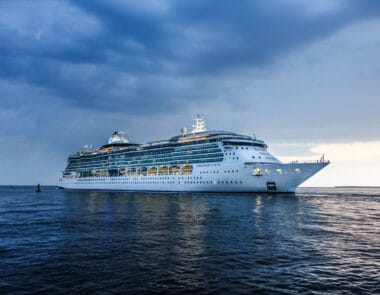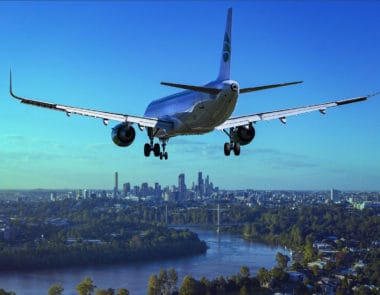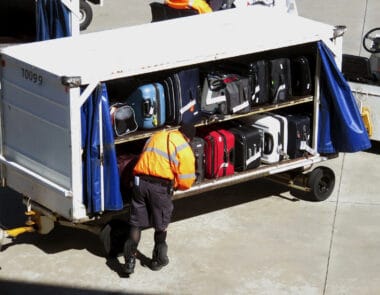Can You Bring Food on an Airplane? TSA Food Rules + Alcohol & Liquids on a Plane in 2024?
Hey, it’s no secret. Buying food at the airport is expensive. Buying food during your flight is expensive. One easy way to get around it? Bring your own from home.
While it may sound like a good idea initially, it’s important to realize that not all food will make it through TSA. Still, there are some snacks and liquids you can bring along.
Here’s everything you need to know about foods you can bring on a flight and which are better left at home (or in your checked luggage).
Table of Contents
The Liquid Rule and How it Relates to Food
Any frequent flier knows the liquids rules or the 3-1-1 rule. You must pack any liquids that you want to bring on a plane, in your personal item or carry-on bag, in individual 3-ounce containers that, all together, fit into one 1-quart bag. (So technically, it’s individual 3.4-ounce containers, but “the 3.4-1-1 rule” just doesn’t have the same ring to it.)
This applies to all your liquids and liquid-adjacent substances. Gels, aerosols, et cetera — it all counts toward your limit.
If you pack your toiletries into a quart-sized bag and only include your liquid items — think shampoo, conditioner, mouthwash, lotion — but leave your toothpaste out, floating around your suitcase, security will stop you, and something will have to go.
Additionally, if you pack a 5-ounce container of shampoo that only has 3 ounces of shampoo actually in it, security will toss it. The containers must hold less than 3.4 ounces at full capacity.
The Vacationer Tip
Amazon offers many Clear TSA Approved Travel Bags and Portable Travel Bottles.
These rules also apply to any drinks or foods that are liquid or, just like toothpaste, liquid-adjacent. So, if you want to bring a bottle of water onto the plane, it has to be in a bottle smaller than 3.4 ounces total (and where are you going to find a bottle of water that small?).
It’s pretty easy to see how difficult this rule makes bringing liquids and semi-liquid foods onto a plane. For this reason, it’s no wonder that most people don’t even try to bring food onto the plane and just shell out the money for some expensive snacks and drinks once they’re in their terminal.
That said, just because getting liquid foods past TSA is difficult, that doesn’t mean it’s impossible — and there are even some exceptions.
Just think of all the food that could potentially fall under the 3.4-ounce rule. Little packs of spreadable cheeses, hummus, condiments, nut butter, yogurt — there are probably more options than you think.
The TSA specifically lists the following foods as approved for your carry-on, in quantities under 3.4 ounces:
- Creamy cheeses
- Liquid chocolate
- Dips and spreads
- Ice cream
- Jam and jelly
- Maple syrup
- Oils and vinegar
- Peanut butter
- Salad dressing
- Salsa
- Sauces
- Soups
- Yogurt
Of course, there are always exceptions. TSA allows children’s food onto the plane in quantities greater than 3.4 ounces and does not require the food to fit into a single, quart-sized bag. The same rule applies to medically-necessary liquid items.
Children’s foods that are permitted on the plane in excess of 3.4 ounces
- Formula
- Breast milk
- Toddler drinks
- Baby and toddler food (including puree pouches)
The TSA also allows you to bring cooling gel packs or ice packs to keep these items cold, and your child does not have to be with you for you to bring these items and the food on the plane.
Of course, you will want to be totally up front with the TSA officer about what you have with you and make their jobs (and your travel day) easier. Pack these items in clear containers and remove them from your carry-on bag for screening.
Further Reading: Ways to Save Money When Traveling with Kids and Flying with a Lap Child Guide
Medicines and other liquids that are permitted on the plane in excess of 3.4 ounces
- Prescription liquids, creams, and gels
- Beverages necessary for certain health conditions, such as diabetes
You can also bring medically necessary accessories for these items such as IV bags, pumps, or syringes.
Special rules for duty-free liquid
Beyond the exceptions and special rules for baby food/liquids and medically necessary liquids, there are also special exceptions for duty-free liquids (think a bottle of perfume or liqueur).
If you’re traveling on an inbound, international flight, you can carry a liquid purchased at a duty-free facility and weighing in at more than 3.4 ounces if it’s in a secure, tamper-evident bag and if, according to the TSA…
- You purchased the duty-free liquids internationally, and you are traveling to the United States with a connecting flight
- The retailer packed the liquids in a transparent, secure, tamper-evident bag, which does not show signs of tampering when presented to TSA for screening
- The original receipt for the liquids is present, and the purchase was made within the last 48 hours
Special rules for alcohol
And, yes, there are even more special rules when it comes to alcohol.
First, you have to stick with that 3-1-1 rule. Your mini bottles of alcohol must fit into that single, quart-sized bag. Additionally, TSA does not allow you to bring any alcohol over 140 proof through the TSA checkpoint in any quantity whatsoever.
Additionally, according to the FAA, you can’t drink alcohol on a plane unless the flight attendant gives it to you (which allows flight attendants to cut off drunk and rowdy passengers as needed).
So, with that said, does it really even make sense to pack those little airplane-sized bottles of vodka in your backpack? Grab a drink at the airport lounge bar before boarding, and then wait until the in-flight drink service to get the party started.
The Vacationer Tip
Read about the Best Credit Cards for Complimentary Airport Lounge Access.
Further rules apply to alcohol in your checked baggage. If you’re traveling with alcoholic beverages that are between 25% and 70% ABV, you can only pack your beverages in quantities of 5 liters per passenger, and the beverages must be in unopened, retail packaging.
Food You Can Bring on the Plane
So all those liquid rules aside, what about non-liquid, totally solid food? That’s where the rules ease up a bit. If it’s solid, it’s basically good to go.
Food items that are okay-ed by the TSA include:
- Bread
- Cake
- Candy
- Solid cheese
- Solid chocolate
- Cooked meat, seafood, or vegetables (with no liquid)
- Cookies
- Crackers
- Dried fruit
- Fresh eggs
- Gum
- Nuts
- Pies
- Pizza
- Sandwiches
The Vacationer Tip
If you are flying to a cruise port, read our guide to Bringing Food, Alcohol, Water, & Snacks on a Cruise Ship.
There are some other foods that the TSA says are technically sometimes okay to bring along, but there are some special considerations, and you may be subject to additional screening if you bring these foods through the security checkpoint. Depending on how that screening goes, the TSA may or may not allow you to take the food on the plane.
These foods include:
- Canned foods
- Fresh fruits and vegetables (some are not permitted due to the risk of pests)
- Fresh meat and seafood (if your meat is packed in ice or something similar, the ice must be entirely frozen at the time of screening; any presence of liquid will mean your item gets left behind)
- Frozen food (the same thing goes — frozen food must be 100% frozen; any liquid means your food can’t go on the plane)
- MREs (these ready-to-eat meals are sometimes not allowed, depending on the airline, due to the self-heating element)
As you consider what snacks you’ll pack in your carry-on, remember that some, even if they are technically TSA-approved, might not be a great fit for the plane environment.
For example, popcorn is going to make a mess. Bringing a Tupperware container of your leftovers isn’t a great idea, either, since it’s not like you can heat them mid-flight. And don’t even think about smelly foods, like tuna and boiled eggs, if you want to stay on your fellow travelers’ good sides. Our Airplane Etiquette Survey revealed nearly 40% of American adults found bringing pungent or foul-smelling food on a plane annoying. In general, it’s also a good idea to avoid common allergens that could impact your fellow travelers, like peanuts.
What to Actually Eat on the Plane
But just looking at a list that tells you the TSA isn’t going to toss your “cooked meat” or “fresh eggs” doesn’t really inspire a lot of tummy rumbling.
What can you bring from home to eat on the plane that’s going to both save you a little cash and also keep you satisfied and happy after you’ve been in the air for multiple hours?
Consider these tantalizing (and TSA-safe) options.
- A grazing box with crackers, dried fruits, nuts, hard cheeses, and cured meats
- A wrap or sandwich that won’t deteriorate over the hours; to keep your bread from going soggy, pack your condiments separately (in tiny pouches less than 3.4 ounces each!)
- A bag of chocolate chip cookies that you baked the night before
- A pasta salad that holds up at room temp (think picnic-ready pasta salads with an oil-based sauce)
- Homemade granola
FAQ
Yes, you can bring most solid foods in a carry-on bag. Liquid or semi-liquid foods are subject to the TSA’s 3-1-1 rule.
Yes, baby formula is one of the few liquids that you can bring onto a plane without following the TSA’s 3-1-1 rule.
Yes, as long as the food is solid, you should be able to bring it onto the plane.
Yes, you can eat on a plane. However, be sure to choose foods with your fellow passengers in mind.
Yes, you can bring spreadable foods on a plane. Spreadable foods are subject to the TSA’s 3-1-1 rule.
Yes, you can bring alcohol on a plane.
Editorial Disclosure: Opinions expressed here are the author’s alone, not those of any bank, credit card issuer, hotel, airline, or other entity. This content has not been reviewed, approved, or otherwise endorsed by any of the entities included within the post.
Get The Vacationer Newsletter
Get highlights of the most important news delivered to your email inbox





